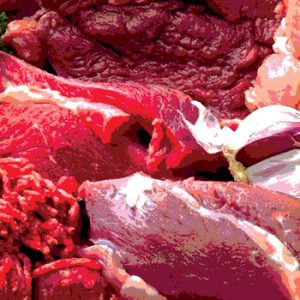Is Michael Pollan becoming the John Irving of food writing? Irving, the author of The World According to Garp and dozens of other whimsical tomes, is often characterized by excessive wordage – as in, great story, but could have been told with half the words.
 Foodie Pollan shows the same characteristics in a longwinded reviewed of a bunch of new books about food politics – because what’s better than preparing and eating food than reading about it and watching others do it on television.
Foodie Pollan shows the same characteristics in a longwinded reviewed of a bunch of new books about food politics – because what’s better than preparing and eating food than reading about it and watching others do it on television.
But there’s a nosestretcher alert hidden in all those words. Pollan writes,
“The 1993 deaths of four children in Washington State who had eaten hamburgers from Jack in the Box were traced to meat contaminated with E.coli O157:H7, a mutant strain of the common intestinal bacteria first identified in feedlot cattle in 1982.”
To clarify: E. coli O157:H7 belongs to a ?family of bacteria called verotoxigenic E. coli (VTEC) first recognized by researchers at Health Canada in 1977. VTEC is used interchangeably with Shiga-toxin producing E. coli, or STEC, and appear to have evolved tens of thousands of years ago.
In 1982, E. coli O157:H7 was first identified as a cause of human disease after 47 people in White City, Ore., and Traverse City, Mich., developed severe stomach disorders after eating McDonald’s hamburgers.
Twenty years later, more than 200 hundred different serotypes –members of the same bacterial strain but with different proteins on their outer shell — have been isolated from humans, foods and other sources. About 150 of these have been isolated from humans, and more than 50 have been shown to cause disease in humans.
Carlton Gyles (above, right, exactly as shown), a leading STEC researcher at the University of Guelph, wrote in 2007 review in the Journal of Animal Science:
Shiga toxin-producing E. coli refers to those strains of E. coli that produce at least 1 member of a class of potent cytotoxins called Shiga toxin. The STEC are also called verotoxin-producing E. coli. The names Shiga toxin (Stx), derived from similarity to a cytotoxin produced by Shigella dysenteriae serotype 1 (O’Brien et al., 1982), and verotoxin (VT), based on cytotoxicity for Vero cells (Konowalchuk et al., 1977), are used interchangeably. Those STEC that cause hemorrhagic colitis and hemolytic uremic syndrome are called  enterohemorrhagic E. coli (EHEC; Levine et al., 1987; Nataro and Kaper, 1998). Ruminants, especially cattle, constitute a vast reservoir.
enterohemorrhagic E. coli (EHEC; Levine et al., 1987; Nataro and Kaper, 1998). Ruminants, especially cattle, constitute a vast reservoir.
The STEC have been characterized by a variety of methods, including serotyping, which is used extensively to categorize strains of E. coli (Blanco et al., 2004a,b; Prager et al., 2005). The serotype of an E. coli isolate is based on the O (Ohne) antigen determined by the polysaccharide portion of cell wall lipopolysaccharide (LPS) and the H (Hauch) antigen due to flagella protein. There are 174 O antigens (numbered 1 to 181, with numbers 31, 47, 67, 72, 93, 94, and 122 deleted) and 53 H antigens in the international serotyping scheme, with E. coli isolates having various combinations of O and H antigens (Scheutz et al., 2004). A high percentage of STEC serotypes are nonmotile (NM) mutants of strains with an H antigen. … Because of the importance of serotype O157:H7 in human disease, it is common to consider STEC serotypes in 2 major categories, O157 and nonO157.
Those non-O157 types are showing up in romaine lettuce. E. coli O145 has sickened some 50 people who consumed lettuce processed by Freshway Foods. However, additional testing revealed another STEC in a bag of Freshway lettuce, which the U.S. Centers for Disease Control and Prevention has types as Escherichia coli O143:H34. That E. coli has not, according to the Columbus Dispatch, been linked to any known food-borne illness here or elsewhere, but it could sicken people.
 Verotoxigenic E. coli (VTec) is a powerful strain of E.coli bacterium that lives in the gut of healthy cattle and sheep and can cause serious illness in the elderly and in children aged under five.
Verotoxigenic E. coli (VTec) is a powerful strain of E.coli bacterium that lives in the gut of healthy cattle and sheep and can cause serious illness in the elderly and in children aged under five. 






 Foodie Pollan shows the same characteristics in a
Foodie Pollan shows the same characteristics in a  enterohemorrhagic E. coli (EHEC; Levine et al., 1987; Nataro and Kaper, 1998). Ruminants, especially cattle, constitute a vast reservoir.
enterohemorrhagic E. coli (EHEC; Levine et al., 1987; Nataro and Kaper, 1998). Ruminants, especially cattle, constitute a vast reservoir.